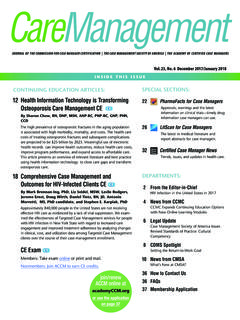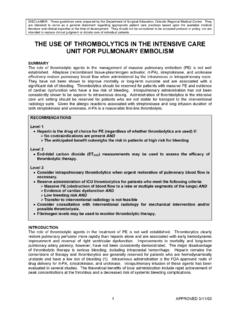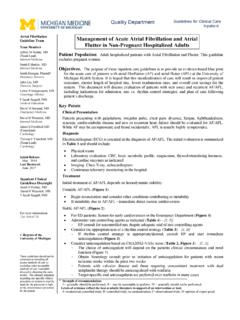Transcription of Chronic Thromboembolic Pulmonary Hypertension (CTEPH): …
1 A Supplement to CareManagement CE FOR CCM & CDMS APPROVED FOR 2 HOURS OF CCM, CDMS AND NURSING EDUCATION CREDIT. Chronic Thromboembolic Pulmonary Hypertension (CTEPH): A Review Jeffrey Wilt, MD; Cassandra Lickert, MD; Michele Cole, PharmD, MS; and Janis Pruett, EdD, RN, MSN, FNP-BC. Introduction data indicate that CTEPH is rare, occurring in only a small Chronic Thromboembolic Pulmonary Hypertension proportion ( 3%) of those who survive a In an (CTEPH) is a rare disease classified by the World analysis of 25 publications and 14 databases conducted Health Organization (WHO) as Group IV Pulmonary in the United States and Europe, the crude annual full Hypertension (PH) and is thought to result from persistent incidence of CTEPH (diagnosed and undiagnosed) was 3. or recurrent Pulmonary CTEPH is defined from to 5 cases per 100,000 75% of patients with the most recent 6th World Symposium on Pulmonary CTEPH had a documented history of acute Incidence Hypertension (WSPH) as mean Pulmonary artery pressure of CTEPH after asymptomatic acute PE is reported to (mPAP) > 20 mmHg (updated from 25 mm Hg from the range from to Other estimates suggest that 5th WSPH), and mean Pulmonary arterial wedge pressure for patients surviving a PE, approximately 4% will go on (mPAWP) </= 15mmHg as measured by right heart cath- to develop Overall the prevalence of CTEPH has erization (RHC)* in the presence of Chronic /organized been reported to be up to per million ,9.
2 Flow-limiting thrombi/emboli in the Pulmonary arteries Unlike other PH subgroups, in CTEPH men and (PAs) after at least 3 months of effective anticoagulation women are equally affected with most registries reporting CTEPH is thought to be underdiagnosed because approximately equal numbers of both sexes. Most cases most patients are diagnosed in WHO Functional Class (FC) occur in the 6th decade of life and according to the 2007. III and IV. Because CTEPH is one of the 5 main diagnostic to 2009 International CTEPH Registry (679 newly diag- categories of PH, it's imperative to distinguish it from the nosed patients < 6 months) about 75% had previous ,3,10. other groups of PH, based on cause, pathophysiology, clin- ical presentation, and treatment options, to diagnose and Risk Factors treat it Currently, CTEPH is the only PH As noted, CTEPH may develop after an acute thrombo- subgroup with a potential cure without lung transplanta- embolic event. It can remain asymptomatic for months.
3 At tion. This article addresses what is known about CTEPH, its diagnosis all patients are symptomatic, and most will be treatment, and related nursing implications. Jeffrey Wilt, MD, is a pulmonologist in East Grand Rapids, MI, Incidence and Prevalence specializing in Pulmonary diseases including CTEPH. Determining the true incidence of CTEPH is difficult Cassandra Lickert, MD, is a pediatrician and allergist, with 10. because most patients with an acute Pulmonary embolus years' experience in clinical practice. (PE) do not undergo routine follow-up assessment of pul- monary pressures or repeat imaging. As well, a surprisingly Michele Cole, PharmD, Masters Applied Pharmacoeconomics and large proportion (25% 67%) of patients with CTEPH Outcomes Research, is a clinician and researcher. cannot remember a history of venous thromboembolism Janis A Pruett, EdD, RN, MSN, FNP-BC, is an experienced (VTE) or ,3 In addition, reported rates vary widely, clinical practitioner, researcher, and nursing educator.
4 Currently, possibly related to differences in the patient populations Janis, Cassandra, and Michele work for Medical Managed Markets studied and the methods of calculating rates. Available and Health Economics and Outcomes Research for Actelion * Pulmonary vascular resistance (PVR) >/= 3 Woods unit, a calcu- Pharmaceuticals, a Janssen Pharmaceutical Company, of Johnson lated value from the RHC is also included in definition. and Johnson. Made possible by an educational grant from Actelion Pharmeceuticals APRIL 2019 | 1. A Supplement to CareManagement CE FOR CCM & CDMS APPROVED FOR 2 HOURS OF CCM, CDMS AND NURSING EDUCATION CREDIT. diagnosed within 2 ,12 CTEPH has been correlated such as chest discomfort and syncope, may with coagulation abnormalities and Chronic inflammatory On physical exam, patients may display typical findings disorders. Previous splenectomy, ventriculoatrial shunt, of PAH and right heart dysfunction, such as jugular venous and infected pacemaker are other independent predictors pressure, tricuspid regurgitation murmur, loud pulmonic of Recently, thyroid replacement therapy and component of the second heart sound, and peripheral malignancy have been reported as risk factors as well.
5 In edema. Pulmonary bruits may predict proximal disease a prospective long-term follow-up study, Pengo identified with turbulent The ECG may be normal or may show several factors that were associated with increased risk of right-sided abnormalities. Chest x-ray and echocardiogram CTEPH, including recurrent PE, younger age, larger perfu- may also reveal abnormalities. sion defects, idiopathic presentation, elevated factor VIII, Hemodynamic parameters must indicate PH; then mis- dysfibrinogenemia, antiphospholipid antibodies, and lupus matched perfusion defects must be verified through addi- tional testing. All CTEPH patients should be assessed with However, many patients with CTEPH will have no clear a right heart catheterization, the gold standard for hemody- history of an acute deep vein thrombosis (DVT) or PE, namic assessment, to provide accurate prognostic informa- and may present these patients may present with worsening tion. A ventilation/perfusion (V/Q) lung scan is performed shortness of breath on exertion.
6 Only after a workup for early in the diagnostic workup. While a low probability scan PAH are they diagnosed with rules out the diagnosis, a high probability scan demon- strates multiple mismatched segmental perfusion defects. CTEPH Pathogenesis Once the disease is diagnosed, surgical accessibility must be The pathogenesis of CTEPH has not been fully determined. Additional tests including Pulmonary angiog- However, it is believed that CTEPH results from Chronic raphy, MRI Pulmonary angiography, and computed tomo- Thromboembolic occlusion of the proximal or distal pul- graphic Pulmonary angiography (CTPA) will determine if monary Over time, resistance to blood flow the patient is a surgical candidate. through the Pulmonary arteries increases, resulting ini- tially from obstruction of Pulmonary arterial vessels by Treatment organized Thromboembolic material and subsequently from Untreated CTEPH patients have a poor prognosis, with the vascular remodeling in small unobstructed Small 5-year survival rate reported at 30% if mPAP > 40 mm Hg, vessel disease in CTEPH may result from overperfusion of and only 10% if the mPAP is > 50 mm Management nonoccluded lung areas; this disease presents histological of the disease has progressed in recent years, and there similarities with the Pulmonary arteriopathy of idiopathic are several options for cure or treatment.
7 For patients with Pulmonary artery Hypertension (IPAH).3 Acute Pulmonary operable disease, the treatment of choice is Pulmonary embolism may also initiate Histological examina- endartertectomy (PEA). tion of resected vascular sections during Pulmonary endar- Pulmonary Endartertectomy terectomy showed organized thrombi of uniform age in most PEA is the only curative treatment option to ,17 It is a cases, suggesting that a single incompletely resolved thrombo- complex surgery involving the surgical removal of Chronic embolic event was responsible for the initiation of the disease. Thromboembolic obstructions, which requires cardiopulmonary In all specimens, intimal thickening with collagen deposition, bypass, induced hypothermia, and circulatory arrest. Therefore, inflammation, atherosclerosis, and calcification was only experienced CTEPH teams can perform this surgery. When PEA is performed by experienced CTEPH teams, the procedure Diagnosis has an operative mortality of approximately 5% with estimated CTEPH is underdiagnosed, perhaps because patients are 1-year and 10-year survival of 90% and 70%, not referred to an expert center or are misdiagnosed.
8 The diagnosis of CTEPH is complex. Patient history is import- Operability ant but may not be conclusive some patients do not report Operability assessment is critical. An expert center is highly a PE history. Patients will present early with exertional recommended to evaluate the patient and to perform sur- dyspnea and later, will have evidence of exertional dyspnea. gery, if indicated. Operability of patients with CTEPH is Late in the disease, evidence of right heart dysfunction, determined by multiple, complex factors that cannot easily Made possible by an educational grant from Actelion Pharmeceuticals APRIL 2019 | 2. A Supplement to CareManagement CE FOR CCM & CDMS APPROVED FOR 2 HOURS OF CCM, CDMS AND NURSING EDUCATION CREDIT. be General criteria for operability include CTEPH suggest that PAH-targeted therapies may be helpful. severity as determined by WHO FC II-IV and surgical acces- Riociguat is a soluble guanylate cyclase (sGC) stimulator sibility of the occluded Pulmonary arteries proximal arter- indicated for use in PAH and for patients with inopera- ies are accessible, while distal arteries are not.
9 Advanced age ble and persistent or recurrent CTEPH after PEA. In the alone is not a contraindication for PEA is the gold Phase 3, 16-week, double-blind, randomized placebo-con- standard and may be curative for those patients with oper- trolled CHEST-1 ( Chronic Thromboembolic Pulmonary able CTEPH, improves survival and quality of life, but not Hypertension sGC-Stimulator Trial) with 216 patients, all patients are surgical candidates. Inaccessible clots and riociguat was associated with significant improvements patient comorbidities preclude About 62% of patients in exercise capacity, PVR, N-terminal prohormone brain are considered eligible for But some patients who may natriuretic peptide (NT-pro BNP), WHO FC, Borg dyspnea be surgical candidates refuse surgery because of or inability index, and quality of life (QoL). Riociguat is orally adminis- to travel to a CTEPH. Of eligible patients, approximately tered 3 times daily and requires an 8-week titration period 17% refuse surgery because of its associated risks.
10 This rep- with multiple dose adjustments before reaching the main- resents 9% of all CTEPH For those patients who tenance Although no other PAH-targeted therapy are deemed nonoperable, have significant comorbidities is currently approved for treatment of CTEPH, several that preclude PEA surgery, or simply refuse PEA surgery, a clinical trials have been conducted in patients with CTEPH. procedure known as balloon Pulmonary angioplasty (BPA) using PAH-specific medications. Macitentan, an endothelin and targeted medical therapy may be considered. receptor antagonist (ERA), was studied in a placebo-con- trolled trial in patients with inoperable CTEPH. MERIT-1. Balloon Pulmonary Angiography (Macitentan in thE tReatment of Inoperable Chronic BPA is an emerging and increasingly performed thera- Thromboembolic Pulmonary Hypertension )20 was a phase 2. peutic option for inoperable CTEPH BPA is a trial that enrolled 80 inoperable patients. The concurrent surgical technique in which serial and progressive dilation use of phosphodiesterase type 5 inhibitors and oral or of stenotic Pulmonary arteries during angiography reduces inhaled prostanoids were allowed.







